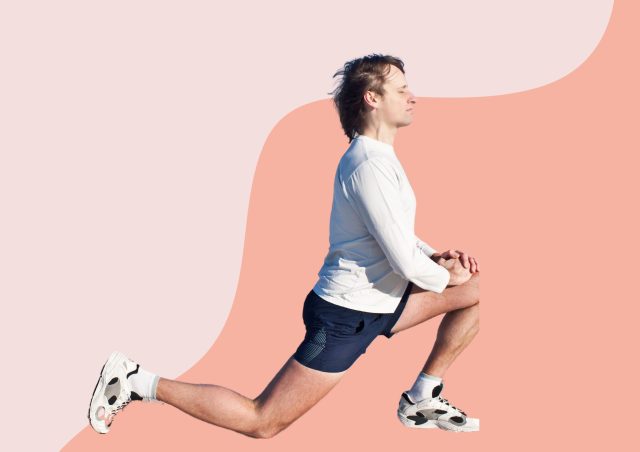4 Ways To Fix A Hip Flexor Strain According To A PT: Complete Guide 2024
By Vanessa Richards
January 10, 2024 • Fact checked by Dumb Little Man

As a fitness enthusiast, you have probably heard about hip flexors. You might feel discomfort in hip flexors many times, which causes hip flexor strains.
No doubt, this vital group of muscles is responsible for moving your knee and leg up toward your body. So, if anything goes wrong with them, you might face difficulties in flexing your hip and bending your knee.
In fact, hip flexors may be stretched and torn for any sudden movements like kicking, sprinting, or any other. But all in all, you will definitely experience many symptoms of hip flexor strain, ranging from mild to severe.
Fortunately, it is possible to treat those symptoms with physical therapies, at-home treatments, and remedies. In this article, we will discuss everything you need to know about hip flexors and how to address strains.
What are Hip Flexors?

Hip flexors are a group of muscles located near the top of the thigh area and pelvic region. Further, hip flexors work by bringing your knee on the way to your chest and waist through bending.
In fact, the hip flexor muscle is comprised of five key muscles which take part in hip flexion. Iliacus muscles and psoas major muscles are considered the prime mover for hip flexion among them. Psoas major muscles are also called the iliopsoas.
Other muscles are rectus femoris, pectineus, and sartorius muscles. Rectus femoris connects the hip joint and knee joint.
The iliacus and psoas hip muscles are combined to flex and externally rotate your hip during any physical activity. Moreover, they play an important role in stabilizing your hip along with your lower back.
However, iliacus and iliopsoas strains can happen due to overusing them. Take rest and seek treatment to alleviate your hip flexor strain symptoms. Most hip flexor strains and pain get healed with these.
However, these hip flexor strains may cause sharp pain, future injury, and sometimes immobility if left untreated. In severe strain, orthopedic surgeons may suggest surgery to reduce pain, prevent injury and overcome associated problems.
Hip Flexor Strain Symptoms
The first symptom of a hip flexor strain begins with pain in the hip or thigh area. In conditions known as tight hip flexors, pain is felt in the front of the hip. Pain increases if one is sitting or making hip flexion movements for long hours.
Apart from that, people may experience other symptoms that are associated with this common orthopedic condition, as mentioned below.
- Cramping in the upper leg muscles
- The upper leg feels sore
- Pulling sensation in the front of the groin
- Difficulty in sprinting, jumping, or kicking
- Stiffness or tightness in the hips, knees, or lower body after being stationary
- Soreness when walking up the stairs
No doubt, most hip flexor strains occur when the muscle fibers of your hip flexor muscle are torn. Overusing hip muscles and tendons or any sudden or acute injury can contribute to a hip flexor strain.
Hip flexor tears fall into the following three different grades based on the severe strain the tear has caused.
- Grade I tear (mild)
- Grade II tear (moderate)
- Grade III tear (severe)
Diagnosis of Hip Flexor Tear or Strain
We have already mentioned the symptoms of a hip flexor tear or strain. If you are experiencing any of those symptoms for longer times, contact your doctor as early as possible. To diagnose your hip flexor strain, your doctor will conduct some imaging tests after examining your medical history.
Most of the time, ultrasound and MRI tests are done to locate the pain point in the body. This test provides them with the opportunity of inspecting whether your injury further damaged any other tissues.
In case you have a fractured hip, your physician can instruct you for an X-ray. After examining all the reports, he/she will recommend the appropriate and best treatment for you.
He might prescribe medication to reduce swelling and pain in the course of hip strain recovery. However, surgery for a hip flexor strain is not necessary unless you have a Grade III or severe strain.
In such a case, you will need to undergo surgery to reattach the damaged tendons or ligaments to your bone. An orthopedic surgeon will take the responsibility of determining and conducting the surgery that is best for you.
What Causes a Hip Flexor Strain?
In general, a hip flexor strain occurs while stretching a muscle or tendon past its limits. Usually, a hip flexor strain or tear is caused by any sudden movement of the hip joint. When you suddenly change the direction of running or perform deep stretching, hip flexor strain is more likely to occur.
However, hip flexor strains are most commonly caused by the following factors.
Overuse
No matter whether you are at work or playing sports, hip flexor strain can result from repetitive motions. For example, when you are cycling, there is always a chance of experiencing hip flexor strain as you use the hip flexor muscles too much.
Athletes who practice martial arts or high knee kicks are more prone to having this problem.
A Lack of Warm-Up before Exercise
Warm-up is considered an important step before exercising. You can prevent injuries and improve the efficiency of your workouts by properly warming up. It is capable of gradually increasing the limit of stress your muscle can sustain during the exercise.
That is why a lack of warm-up before exercise can contribute to hip flexor strain and injury.
Flexibility Issues
The muscles in your body are at risk of strain if you are not flexible enough and have tight muscles. Staying physically idle all through the day shortens hip flexor muscles. These shortened muscles are not able to create as much power as the lengthened muscles.
You may face problems while attempting to activate these muscles.
Traumas
Hip flexor strains can be caused by any acute trauma, such as car accidents or falls. This is especially true in case you tense your muscles during a fall.
A strain or tear means any damage in a hip muscle or tendon due to excessive stretching. Sudden movements are mainly responsible for these strains. Muscle tears can be mild to severe considering how severe the pain, immobility, and weakness are.
4 Ways To Relieve Pain & Tightness From A Hip Flexor Strain
There is no doubt that hip flexor strains can be treated by taking proper rest along with reducing physical activities. It is possible to treat most hip flexor strains with the help of the RICE method.
1. RICE Method
This method consists of the following four steps.
- First Step – Rest
- Second Step – Ice
- Third Step – Compression
- Step 4- Elevation
However, there are many hip flexor stretches, specialized digital programs, and remedies available for treating a hip flexor strain. So, we want to discuss some other methods to deal with this problem.
2. Hip Flexor Stretch
Gentle stretching exercises are proven very much effective in lowering hip flexor muscle tension. In addition, it can minimize the chance of future injury. To stretch your hip flexor, you have to follow the following steps.
- Bend on the right knee and place a folded towel beneath the kneecap.
- To maintain stability, stretch the left leg while bending your left knee along with keeping your left hand on it.
- To avoid bending at the waist, keep your right hand on your hip, along with straightening your back and tightening your abdominal muscles.
- After that, lean forward to shift more body onto your right leg. Now, you will experience a stretch on the right thigh.
- Hold this process for at least 30 seconds.
- Now, switch to the other leg and repeat the same process.
When it comes to hip flexor stretches, below are the most popular ones. You can consult a physical therapist or trainer to help you with these.
- Hyperbolic Stretching
- Supine Hip Flexor Stretch
- Half-Kneeling Hip Flexor Stretch
- 90/90 Stretch
- Side-Lying Hip Flexor Stretch
In this regard, we want to introduce a program that will help you practice the hip flexor stretch.
3. Digital Programs/Guides
1. Addresses All Aspects of Fitness and Flexibility: Hyperbolic Stretch
This advanced result-driven fitness program is treated as one of the most effective fitness programs of the present time. It is designed with the aim of unlocking and maximizing your performance potential within 4 weeks. This revolutionary gender-specific program is claimed to be capable of improving your entire body flexibility through stretching exercises.
However, it is all about following a few workout routines that are briefly described in the hyperbolic stretching routine guide. The guide also offers one-on-one training with people of all ages and sizes. In fact, more than 100 scientific studies are cited in this guide to support the techniques quite well.
Shop Hyperbolic Stretching Program at the Official Website.
Full Article: Hyperbolic Stretching Review: Does it Work?
2. Loosens Locked And Tight Hip Flexors: Unlock Your Hip Flexors
The Unlock Your Hip Flexors is an easy-to-follow specialized digital program consisting of a variety of hip flexor exercises. In addition, it comes with a workout program to help you in loosening your locked and tight hip flexors.
It works by fixing your stiff hips by relaxing your psoas muscles around them. And it is proven very much effective for individuals who usually sit or perform strenuous exercises for a longer period.
Shop Unlock Your Hip Flexor Program at the Official Website.
Full Article: Unlock Your Hip Flexors Review: Does it Really Work?
4. Medicines to Heal Hip Flexor Tear
There are some medicines to fight this painful problem. Acetaminophen, naproxen sodium, and ibuprofen are some medicines to get some relief.
However, these medicines should not be taken without a doctor’s prescription. Prolonged intake of these medicines can cause internal bleeding.
Conclusion
So, hip flexors are one of the most important muscle groups to remember when working out. They play a key role in tilting the pelvis forward and compressing your lower back while having tight hip flexors.
No doubt keeping them flexible and strong can prevent complications down the road.
Neglecting them for a long period may result in additional pains and problems that may disturb your quality of life.
Fortunately, there are some simple exercises and stretches a person can perform to maintain a strong and healthy hip. But among them, we highly recommend Unlock Your Hip Flexors as it is proven most effective in increasing your flexibility and range of motion.
Click Here To Get The Unlock Your Hip Flexor Program at a Discounted Price.
>>Related Article: 7 Simple Flexibility Exercises for Improving Your Mobility
Hip Flexor FAQs
What Causes Weak Hip Flexor Muscles?
Many reasons can be attributed to a weak hip flexor muscle. Lack of exercise, sitting for long periods, and overusing these muscles can all be the possible culprits behind it. Furthermore, people with osteoarthritis in the hip or cerebral palsy may experience weak hip flexor muscles. But most of the time, our sedentary lifestyle contributes to muscle weakness in the hips.
However, hip muscle flexor is a common issue and can be treated with physical therapy, walking, and exercises. You can find many hip flexor exercises that can be easily performed in the gym or at home by targeting those weak muscles.
What is the Fastest Way to Heal Hip Flexor Strains?
Unfortunately, it is not possible to find any instant remedies. Physical therapies or at-home treatments help to alleviate hip flexor strain.
For example, you can rest the strained muscle and avoid physical activities to minimize the chances of further strain. In addition, you can also apply a heat pack and ice pack on the affected area to treat the strain.
How to Strengthen Hip Flexors?
Great tools to strengthen your hip flexor are stretching, and a hanging leg raise. Stretching relieves the stress in hip flexor muscle fibers.
Hanging leg raises can be done on the floor with your overhand grip hooked up to a cable pulley. After that, just raise your leg as much as you can. This is proven very much effective in strengthening the hip flexors.
Vanessa Richards
Vanessa is a mom of 3 lovely children and a software geek. Outside of her career as a health and wellness instructor. She enjoys writing and researching on topics such as finance, software, health and culinary.




